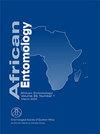Effect of Glucose, Agar Supplementation and Bacterial Cell Density on the in vitro Liquid Culture of Steinernema jeffreyense
IF 1.2
4区 农林科学
Q3 ENTOMOLOGY
引用次数: 2
Abstract
Entomopathogenic nematodes (EPNs) of the family Steinernematidae are effective biological control agents against important pest insects. The in vitro liquid culture method of mass production is used to produce EPNs of high quantity, quality and with reduced cost by upscaling. The first step in liquid mass production is the use of shake flasks to obtain monoxenic infective juvenile (IJ) inoculum for optimisation purposes, followed by upscaling to a desktop fermenter. This study was undertaken to assess the impact of the addition of agar and glucose to the culture medium, as well as assessing the impact of bacterial cell density inoculum on IJ recovery and yield. Steinernema jeffreyense was cultured in 250 ml Erlenmeyer flasks, with the mutualistic bacterium Xenorhabdus khoisanae. In this study the impact of four different agar and glucose concentrations showed negligible impact on nematode recovery and yield. Different initial bacterial inoculum densities inoculated to the culture medium showed a low inoculum density of 2 % (6 × 106 cells) of the bacteria culture to be the optimal inoculum concentration. A bacterial growth curve for X. khoisanae in tryptic soy broth, showed 40–44 h to be the optimum time for introduction of the initial nematode inoculum into the complex medium.葡萄糖、琼脂补充和细菌细胞密度对杰夫雷氏Steinerma jeffreyense体外液体培养的影响
Steinermatidae科昆虫病原线虫是防治重要害虫的有效生物防治剂。大规模生产的体外液体培养方法用于通过扩大规模生产高数量、高质量、低成本的EPN。液体大规模生产的第一步是使用摇瓶获得用于优化目的的单性感染幼年(IJ)接种物,然后升级到台式发酵罐。本研究旨在评估向培养基中添加琼脂和葡萄糖的影响,以及评估细菌细胞密度接种物对IJ回收率和产量的影响。Steinerma jeffreyense在250ml锥形烧瓶中与互惠细菌Xenorhabdus khoisanae一起培养。在这项研究中,四种不同琼脂和葡萄糖浓度对线虫恢复和产量的影响可以忽略不计。接种到培养基上的不同初始细菌接种物密度表明,细菌培养物的2%(6×106个细胞)的低接种物密度是最佳接种物浓度。在胰蛋白酶大豆肉汤中的X.khoisanae细菌生长曲线显示,40–44小时是将初始线虫接种物引入复杂培养基的最佳时间。
本文章由计算机程序翻译,如有差异,请以英文原文为准。
求助全文
约1分钟内获得全文
求助全文
来源期刊

African Entomology
生物-昆虫学
CiteScore
2.00
自引率
0.00%
发文量
17
审稿时长
6-12 weeks
期刊介绍:
African Entomology (ISSN 1021-3589 – print / 2224-8854 – online) replaced the old Journal of the Entomological Society of Southern Africa in 1993. A single volume consisting of two issues (March and September) is published annually. The journal is indexed in all major abstracting journals
African Entomology is a peer reviewed scientific journal that publishes original research articles and short communications on all aspects of entomology, with an emphasis on the advancement of entomology on the African continent.
 求助内容:
求助内容: 应助结果提醒方式:
应助结果提醒方式:


